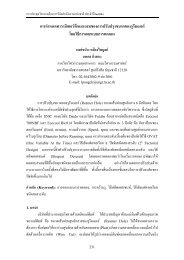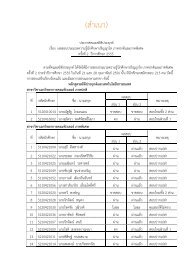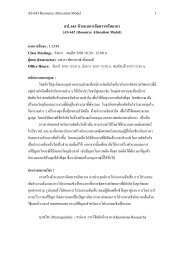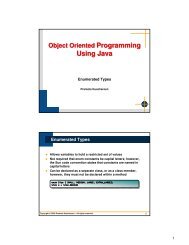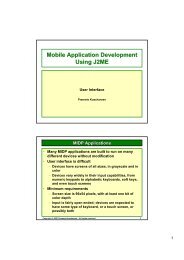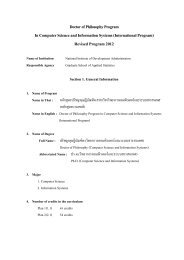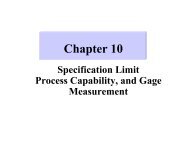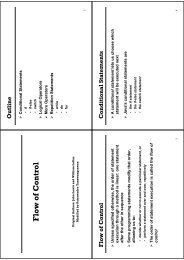ดาวน์โหลด All Proceeding - AS Nida
ดาวน์โหลด All Proceeding - AS Nida
ดาวน์โหลด All Proceeding - AS Nida
You also want an ePaper? Increase the reach of your titles
YUMPU automatically turns print PDFs into web optimized ePapers that Google loves.
From the process settings for all influential process variables<br />
in Table 5, the performance after the improvement for two phases can<br />
be evaluated from the meandering data. After an implementation, it has<br />
been found that the average of the response from Scenario 2 is lower<br />
than the current manufacturing system as described in the figure of a<br />
box-whisker plot (Fig. 4).<br />
Data<br />
7<br />
6<br />
5<br />
4<br />
3<br />
Box-Whisker Plot of Meandering Data from all Three Scenarios<br />
Previous<br />
Scenario 1<br />
Scenario 2<br />
Fig. 4 Box-Whisker Plot of Meandering Data from all Three Scenarios.<br />
A confirmation technique for analysing experimental data of<br />
the meandering tolerance is measured under various operating<br />
conditions. It can also be seen that these experimental results on all<br />
scenarios were statistically significant with 95% confidence interval<br />
(Table 6). The numerical results suggested that Scenario 2 provided the<br />
better performance in terms of the average meandering tolerance (Fig.<br />
5). The goodness of the linear statistical model via experimental errors<br />
or residuals is also adequate (Fig. 6). As the results, Scenario 2 is then<br />
applied to the manufacturing system under a consideration of the<br />
reduction of meandering tolerance achieved.<br />
Table 6. One-way ANOVA: Meandering versus Scenario.<br />
Source DF SS MS F P-Value<br />
Scenario 2 88.9007 44.4504 646.16 0.000<br />
Error 57 3.9211 0.0688<br />
Total 59 92.8218<br />
49<br />
Percent<br />
Frequency<br />
99.9<br />
99<br />
90<br />
50<br />
10<br />
1<br />
0.1<br />
-1.0<br />
16<br />
12<br />
8<br />
4<br />
0<br />
Fig. 5 Graphical Comparison for Three Scenarios.<br />
Normal Probability Plot Versus Fits<br />
-0.5<br />
0.0<br />
Residual<br />
0.5<br />
-0.8 -0.6 -0.4 -0.2 0.0 0.2<br />
Residual<br />
Residual Plots for Response<br />
0.4<br />
1.0<br />
Residual<br />
Residual<br />
0.5<br />
0.0<br />
-0.5<br />
-1.0<br />
3<br />
0.5<br />
0.0<br />
-0.5<br />
4<br />
5<br />
Fitted Value<br />
Histogram Versus Order<br />
Fig.6 Model Adequacy Checking.<br />
-1.0<br />
1 5 10 15 20 25 30 35 40 45 50 55 60<br />
Observation Order<br />
5. CONCLUSIONS<br />
In this study there are some qualitative process variables that<br />
need to be in forms of integer whereas the remaining variables are<br />
quantitative. This mixed integer linear constrained response surface<br />
optimizations model provides the new operating condition. The<br />
experiment in this research was restricted to only one cycle.<br />
Consequently conclusions may not be the global optimum. The<br />
experimental results showed that it brings the meandering close to the<br />
target and within specification. After an implementation, the<br />
meandering is close to the target when compared. The tolerance is<br />
changed from 5.90 to 3.16 microns. Consequently, this reduces the level<br />
of production cost and also time and labor.<br />
ACKNOWLEDGMENT<br />
The authors wish to thank the Faculty of Engineering,<br />
Thammasat University, THAILAND for the financial support.<br />
6




